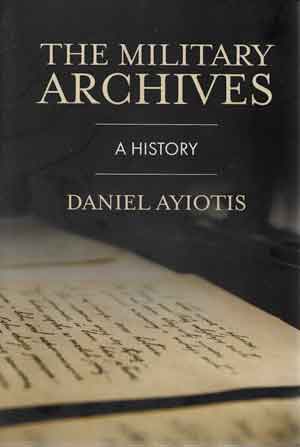THE MILITARY ARCHIVES: A HISTORY
Published in Book Reviews, Book Reviews, Issue 2 (March/April 2023), Reviews, Volume 31DANIEL AYIOTIS
Eastwood Books
€25
9781913934330
Reviewed by Marie Coleman
Marie Coleman is Professor of Twentieth-Century Irish History at Queen’s University Belfast.
I first visited the Irish Military Archives in November 1993 to conduct research for my undergraduate history dissertation on the Irish Civil War. Thirty years later the archives’ collections—in particular the on-line Military Service Pensions Collection and the Bureau of Military History—remain central to my daily work as a researcher and teacher. As a regular user of these collections, I was fascinated by this account of the origins and development of the Military Archives, written by its current director, Commandant Daniel Ayiotis.
There has been much focus in the past year on the centenary of the establishment of the Irish state and its defence forces. As this book shows, even at that evolutionary stage, key individuals within the emergent army recognised the importance of establishing a secure repository for the archival record of the state’s defence forces. Researchers who benefit from the collections held by the Military Archives today owe a debt of gratitude to the foresight of army officers such as Piaras Béaslaí and J.J. Burke, who, even while the Civil War was raging, were collating ‘War Records’, material related to Béaslaí’s contemporaneous work on a biography of Michael Collins.
In June 1923 Béaslaí outlined the significance of this work for posterity: ‘What we are really doing is collecting material and records which would be of great value for reference as a complete history of the Irish Volunteers, IRA, and the starting of the Regular Army, as well as the Anglo-Irish and Irregular [i.e. Civil] Wars’.
Since its release in 2014 the Military Service Pensions Collection has become the best-known collection held by the archives, and its importance to the establishment of the archives in the first place is recognised by Ayiotis, as it was by the army’s civilian clerk, Thomas Galvin, in 1924. Following the enactment of the first Military Service Pensions Act in that year, Galvin assembled newspaper reports and related data to support the work of assessing pension claims.
Students of Ireland’s military history prior to independence will find the discussion of Galvin’s preservation of the so-called ‘Kilmainham papers’ noteworthy. The retention of these papers, including ‘Correspondence and Papers of the Commanders-in-Chief of the Forces in Ireland’ between 1784 and 1894, highlights the vicissitudes of archival survival: ‘These records were discovered discarded in a cellar in the main building of Army GHQ’. The eventual transfer of this collection to the National Library in 1936 because of the Military Archives’ restricted focus on the Irish revolutionary period at that time is now considered to be ‘a tremendous loss to the Military Archives’.
The decision to narrow the archives’ remit to the events of the years between 1913 and 1921 is examined in detail in Chapter 3, which includes a discussion of the ‘Anglo-Irish Conflict Project’ promoted in the 1930s by various archives staff and directors, including Eamonn Vincent O’Carroll, Liam Archer and J.J. ‘Ginger’ O’Connell. This project, of which many readers will not have been aware previously, was effectively the forerunner of what would emerge in the late 1940s as the Bureau of Military History (BMH). While a significant amount has been written about the BMH, especially since its release in 2003, this chapter provides valuable context that enhances our understanding of how that project came about.
Almost half of this book is dedicated to the evolution of the modern archives, from the appointment of Commandant Peter Young as director in 1982 to the present day. This emphasis is a reflection on the extent and speed of development during these past 40 years, though arguably there remains room for further analysis of the years following the Second World War/Emergency, and especially the impact of Ireland’s membership of the United Nations, which expanded the army’s international remit considerably.
The dedication of two significant chapters to Peter Young is entirely appropriate. Users of the new archives building, opened in 2016, might recognise his name solely from the eponymous reading room. For those who did not have the privilege of visiting the archives while Peter was director (in its older red-brick location, also on the Cathal Brugha Barracks site) and availing of his photographic memory for where every piece of paper in the archive was stored, the tea and biscuits, and the tales of acting as an adviser on Neil Jordan’s Michael Collins, these chapters explain his immense legacy to Irish archives and history.
While I knew the outlines of Peter’s career, his efforts to secure the release of the Bureau of Military History and his collaboration with Caitriona Crowe of the National Archives in securing the survival of the Military Service Pensions Collection, I learned much more about his wider career. Living as I now do in Belfast, the discussion of his role as a press officer during the early Troubles and his interaction with some of the leading journalists covering that conflict (including the late Robert Fisk, whom the author had been able to interview a year before Fisk’s death) was particularly enlightening. This is not only a valuable discussion of Peter Young’s life and career but also a valuable insight into the Irish army’s approach to the Troubles.
It is an immense regret that Peter Young never lived to see the new archives building wherein his legacy is remembered in the name of the reading room. A purpose-built archive where researchers can access much of the historical record of Irish independence and of the defence forces of the independent state is surely a realisation of his vision. Daniel Ayiotis has recorded the contribution of Young and his other predecessors as director in a highly engaging and readable account of Ireland’s Military Archives.

















